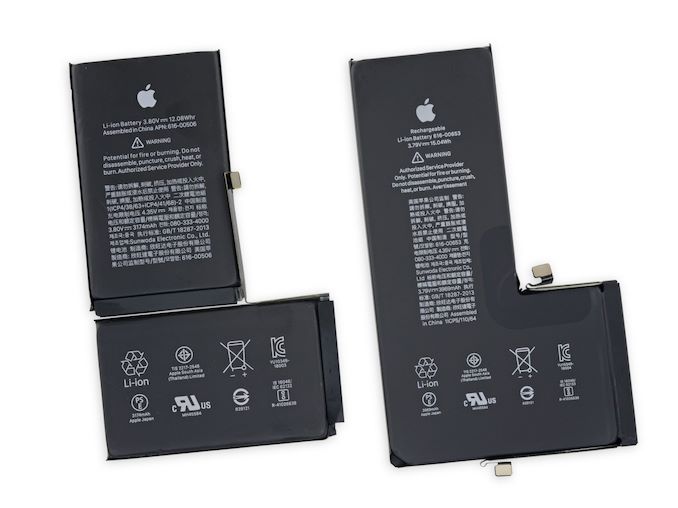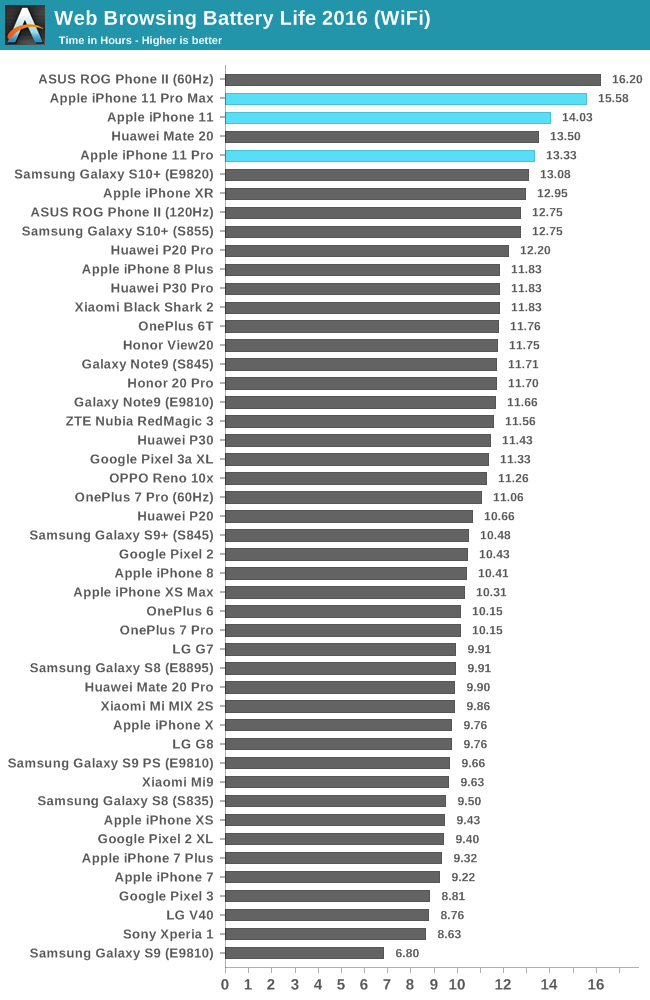The Apple iPhone 11, 11 Pro & 11 Pro Max Review: Performance, Battery, & Camera Elevated
by Andrei Frumusanu on October 16, 2019 8:30 AM ESTBattery Life - A Magnitude Shift
By now many will have heard positive things about the new iPhone 11s' battery life. As we have covered in the introduction, possibly the biggest changes to Apple’s line-up this year is the device’s vastly increased battery capacities. The Pro models in particular have seen significant increases: the 11 Pro gets a 3046mAh battery which represents a 14.5% increase compared to the XS, and the 11 Pro Max gets a 3969mAh battery which represents a very large 25% increase. The Pro Max is now the first Apple device which has a battery capacity comparable to Android phones out there, some of which have offered similar large capacities for a few years now.

iPhone XS Max vs. iPhone 11 Pro Max Batteries (Image Courtesy iFixit)
The regular iPhone 11 sees only a 5.7% bump to up to 3110mAh, which isn’t all that big upgrade compared to the XR. But it also doesn’t increase its weight nearly as much as the Pro models.

The battery results in our web test are outstanding. Apple in this generation has gone from being average in battery life to showcasing some of the best results we’ve seen in the market.
What is very interesting here is how our absolute test runtimes end up compared to Apple’s marketing claims. Apple has promised +1H, +4H and +5H of battery life for the 11, 11 Pro and the 11 Pro Max compared to their predecessors, and what we measured is 1.08H, 3.9H and 5.27H, which is pretty damn near Apple’s promoted figures, pointing out to some very similar testing conditions between our test and Apple’s internal metrics.
If we break this down a bit and theorize a bit, if we take the XS Max 10.31H result, multiply by 1.25x for the increased battery capacity (12.88H), multiply again naively by 1.15x for the more efficient screen (14.82H), we’re left with a ~5% margin which would account for the more efficient SoC. Give or take margin of error here or there, the results we’re seeing shouldn’t be all too surprising. The math would also check out for the iPhone 11 without a newer display: 5% increased battery capacity and an on average ~3% more efficient SoC.
There’s not much to say about the new iPhone 11 series' battery life other than it's exemplary. More importantly, Apple has managed to finally catch up and exceed the battery life of the LCD iPhone 8 and Plus models from 2 years ago.










242 Comments
View All Comments
Jon Tseng - Wednesday, October 16, 2019 - link
Nice! Any additional thoughts on the U1 UWB chip. I guess not much you can do with it yet but to me the possibilities are intriguing...Andrei Frumusanu - Wednesday, October 16, 2019 - link
I think Apple has more plans with it in the future, but yes right now it doesn't do very much.tipoo - Wednesday, October 16, 2019 - link
Definitely think it's getting the hardware ready for the AR glasses. Hyper precise location tracking just by putting your phone down on a desk and having the U1 chips communicate.Diogene7 - Wednesday, October 16, 2019 - link
I am dreaming of that the Apple U1 UWB chip could be used in a not too distant future (2020 / 2021) for precise spatial locasization for at (short) distance wireless charging : by knowing where exactly in space an Apple device is, Apple might be able to dynamically and efficiently focus wireless energy transfer maybe through wireless resonant charging (Airfuel) for an iPhone or through RF charging like Energous / Ossia for recharging Apple Airpods from an iPhone...I think I am dreaming, but just hope that Apple is working hard to make wireless power at a short distance a reality : I would dream to be able to drop my iPhone anywhere on my bedside table, and that it automatically recharge during the night from a base station up to a distance of 1,5 foot / 50cm : it would bring sooooo much more convenience than Qi wireless charging...
patel21 - Wednesday, October 16, 2019 - link
Man, you are lazy.Diogene7 - Wednesday, October 16, 2019 - link
@patel21 : How many times do you still plug an Ethernet cable to your laptop to surf on internet instead of using WIFI ? WIFI is simply more convenient...Similarly, wireless charging at a distance (up to ~ 1,5 foot (50cm)) would be so much more convenient than to have to plug a cable to recharge a device
It also true for Internet of Things (IoT) devices : tjere seems to be some studies showing that consumers stop using many IoT devices that work on batteries because they have to change the batteries
I strongly believe that wireless charging at a short distance is a requirement for the sale of IoT sensors to really take off because managing 10s or 100s or more of IoT devices with batteries is not really manageable by consumers in the long run...
Molbork - Tuesday, June 16, 2020 - link
And you just halved the power efficiency of your laptop and devices. EM transmission power is 1/r^2, checking your laptop could cost you 2-3x more than a direct connection at longer distances.Henk Poley - Friday, October 18, 2019 - link
I wonder if they'll do things like heart- and breathing-rate measurement, and counting of people around you (how many hearts). Such as was demonstrated for radar based baby monitoring. Fairly low power, a 'cigarette pack' size device attached to a baby cot could work for half a year by only periodically measuring.Could be interesting for meetings, that your phone knows everyone has arrived, people were agitated, etc.
Adonisds - Wednesday, October 16, 2019 - link
Why is it required less than double the power to produce twice the display brightness?michael2k - Wednesday, October 16, 2019 - link
Displays aren't actually perfectly transparent, and the light generating devices might absorb some of the energy instead of transmitting it.Increasing transparency is one way to produce more brightness with less energy.
Reducing the amount of energy absorbed by the LEDs (and thus transformed into heat) is another way to produce more brightness with less energy.
Changing the LEDs basic chemistry to more efficiently transform electricity into light is a third way.
Fundamentally less waste heat, more light.